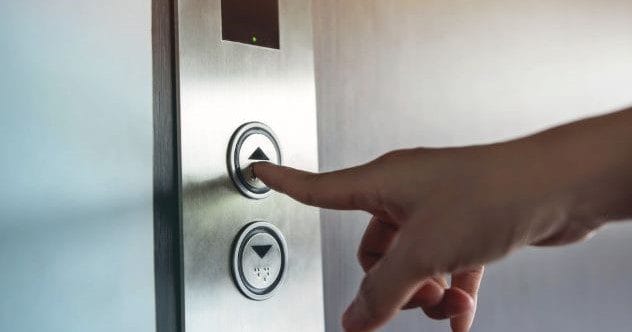If you’re like many city dwellers, you probably use an elevator every day. Whether it’s in your apartment building or at the office, elevators are an essential part of life. It seems simple: step inside, press a button, and you’re there. But elevators have a fascinating history, and their invention significantly impacted how cities were designed and built.
In this list, we’ll explore ten unique elevator-related facts. Get ready to rise and learn about an invention you probably haven’t thought much about!
10. Put Up or Shut Up
In the early days of elevators, riding in one could be dangerous. If the cables snapped, riders could fall to their deaths. That is, until Elisha Otis came along. The Otis Elevator Company is known for building, maintaining, and repairing elevators. In the 1850s, Elisha changed the elevator business with a shocking demonstration.
In 1854, the Otis Elevator Company invented a device that would stop an elevator from falling if its rope broke. To prove his invention, Elisha went to the World’s Fair at the Crystal Palace in New York City. He rode an elevator platform high into the air and then had the rope cut. The elevator didn’t fall, and the crowd was amazed. This event significantly increased trust in elevator safety technology. Soon, Otis’s design was in nearly every building in New York City and beyond. [1]
9. Turn It Up, Please…
Elevator music is meant to have a calming effect. It’s even become an insult for music that people find boring. But a century ago, elevator music had a specific purpose. In the 1920s, building managers started playing music in elevators because people were nervous about riding them. There was a fear that elevators would crash, even after Elisha Otis’s safety demonstration.
Operators used music to ease people’s fears and distract them from possible dangers. Elevators also moved much slower back then, making silences awkward. Elevator music was born to address both these needs. [2]
8. Straight to the Top!
Elevators are responsible for city skylines in places like New York City, London, and Tokyo. Without advancements in elevator technology in the 19th and 20th centuries, skyscrapers wouldn’t exist. It’s quite simple, really. A 40- or 50-story building with only stairs would require workers to spend too much time and energy walking up and down.
When Elisha Otis installed the first elevator in a public building in New York City in 1857, it changed how people worked and lived. Before elevators, most buildings were only two or three stories high. As elevators became more reliable, people increasingly wanted to live in cities where the jobs were. Architects and building managers could now build upwards, leading to more offices, apartments, and people in city blocks. Cities like New York and London saw huge population growth, and the modern skyscraper became a standard. [3]
7. The Greeks Did It First
While elevators enabled the creation of modern skyscrapers, the concept dates back much further. The ancient Greeks created the first primitive elevator system. Archimedes designed a pulley system in 236 BC to lift people, goods, and animals between levels.
According to Vitruvius, Archimedes’s elevator used a water wheel as its base mechanism. Ropes were tied around animals or lifted by people to raise the platform to higher floors. The Romans also used this style of elevator. In ancient Rome, the Colosseum featured subterranean rooms and tunnels. When gladiators or animals were needed in the arena, hundreds of men would use counterweights and winches to hoist platforms upwards. These early elevators served the same basic purpose as today’s versions. [4]
6. Top Floor, Please… and Step on It!
The fastest elevator in the world is in the Shanghai Tower, reaching speeds of up to 45 miles per hour (72 kilometers per hour). This elevator travels from the ground floor to the 119th floor.
The Shanghai Tower’s elevator holds the Guinness World Record for being the fastest. The Nextway lift, made by Mitsubishi Electric, travels from the second-level basement to the 119th floor in just 53 seconds. At top speed, it moves at about 67 feet per second (20 meters per second). The ride is supposedly very smooth, so you might not even feel like you’re speeding upwards. [5]
5. Jump on Quick!
Not all elevators were built like the ones we know today. In Europe in the early 20th century, the Paternoster Elevator was popular. It had some unique features. For one, it never stopped at any floor. It just moved continuously up and down the building, and it had no doors!
The Paternoster was like a constantly open elevator shaft with a platform that slowly moved. Because there were no doors, people had to jump on quickly. When they reached their floor, they simply stepped off as the lift kept moving. Think of it like an escalator but for an old-fashioned elevator. Riders had to stay focused and act quickly to hop off at the right time. [6]
4. And They’re Still Working!
Some Paternoster elevators are still in use today. The oldest working elevator is a Paternoster model in the Oriel Chambers building in Liverpool, England. Designed and put into operation in 1868, it’s still going strong. The Paternoster was developed by British engineer Peter Hart, who spent years working on the design before patenting his Cyclic Elevator.
After Hart’s design became popular in Liverpool and London, it spread elsewhere in Europe. These elevators were efficient, easy to use, and rarely broke down. The Oriel Chambers elevator is nearly 200 years old! Other paternosters are still working in Britain, such as at Sheffield University. However, none are as old as the one at the Oriel Chambers. [7]
3. Eiffel’s Secret Elevator
Elevators can be found in unexpected places. The Eiffel Tower has several public elevators in the North, East, and West pillars, as well as one for customers of the Jules Verne restaurant. But there’s also a secret elevator meant for one man: Gustave Eiffel. While designing the tower, Eiffel built himself a small apartment on the top level, complete with plush rugs, oil paintings, and a grand piano.
To reach his apartment, he installed a small, private elevator that only he and his friends could use. Few others ever visited Gustave’s apartment, though some VIPs like Thomas Edison were allowed. Mostly, Gustave kept the apartment and its private elevator to himself. [8]
2. Don’t Touch That!
Studies show that elevators are common sources for spreading germs. Elevators are enclosed, small spaces with limited airflow. Everyone touches the same buttons. During cold and flu season, germs are easily left on the buttons.
This is a serious problem, especially in hospitals. Experts worry about pathogens spreading to patients with weakened immune systems. In response, elevator companies and architects are creating touchless elevators. While this won’t eliminate germs completely, it could significantly reduce the spread of infections by preventing so many people from touching the same buttons. [9]
1. Relying on Backup Brakes
In the modern age, elevator plunges are very rare. You might get stuck in an elevator, which is annoying, but not deadly! The deadliest scenario would be a cable snapping and a high-speed plunge to the ground floor. However, cables are made of durable steel, and elevators have braking technology to prevent plunges.
Like cars, elevators have emergency brakes that are ready for use. Unlike the manual brakes in cars, elevator brakes are automated. The elevator tracks its speed. If it exceeds a safe rate, the emergency brakes automatically engage, preventing a freefall. Elevators are super-safe with routine inspections and backup systems like emergency brakes. [10]
Conclusion
From their ancient origins to modern skyscrapers, elevators have come a long way. They’ve shaped our cities, influenced music, and even have secret apartments. Next time you step into an elevator, remember these fascinating facts!
What’s the most interesting elevator experience you’ve had? Leave your comment below!










